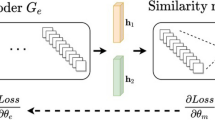Abstract
Gearbox is an important part of mechanical equipment. If a fault cannot be timely detected, it will cause significant economic losses. In order to solve the problem of early fault diagnosis quickly and accurately, this paper proposes a feature extraction method by the decomposition of feature value to the waveform of signal, and inputs the extracted feature into the deep learning network established by this paper. Firstly, the input signal is reconstructed and the feature value is decomposed. Secondly, the extracted features are input into the established deep learning network as the deep learning signals to carry out fault diagnosis. Finally, the fault is identified by the established deep learning network. In a number of experiments, to compare with the existing some fault diagnosis methods, such as support vector machine, classical neural network, lifting wavelet and logical regression, the experimental results show that the average accurate recognition rate of the proposed method by established deep learning network based on feature value decomposition to fault diagnosis is 96.65%, its variance is 0.36 and the diagnostic speed is 0.612 s. However, the average accuracy of the best diagnostic method at present is 93.52%, the variance is 0.47 and the diagnostic speed is 0.826 s. It indicates that the proposed method has a good accuracy, stability and fastness.















Similar content being viewed by others
References
Bruna J, Mallat S (2013) Invariant scattering convolution networks. IEEE Trans Pattern Anal Mach Intell 35(8):1872–1886
Cho W, Yu NY (2018) Secure communications with asymptotically Gaussian compressed encryption. IEEE Signal Process Lett 25(1):80–84
de Mendívil JRG (2018) Conditions for minimal fuzzy deterministic finite automata via Brzozowski’s procedure. IEEE Trans Fuzzy Syst 26(4):2409–2420
Fischer A, Igel C (2013) Training restricted Boltzmann machines: an introduction. Pattern Recognit 47(1):25–39
He Y, Li B (2016) A combined learning strategy for deep learning model. J Autom 42(6):953–958
Hinton G (2012) A practical guide to training restricted Boltzmann machines. In: Montavon G, Orr GB, Müller K-R (eds) Neural networks: tricks of the trade. Springer, Berlin, pp 599–619
Hinton GE, Osindero S, Teh YW (2006) A fast learning algorithm for deep belief nets. Neural Comput 18(7):1527–1554
Huang J, Hu X, Yang F (2011) Support vector machine with genetic algorithm for machinery fault diagnosis of high voltage circuit breaker. Measurement 44(6):1018–1027
Jiang T, Yuan S (2014) Diagnosis of rolling bearing based on improved wavelet neural network. J Huazhong Agric Univ 33(1):131–136
Jiang H, Zhang H (2018) Iterative ADP learning algorithms for discrete-time multi-player games. Artif Intell Rev 50(1):75–91
Kankar PK, Sharma SC, Harsha SP (2011) Rolling element bearing fault diagnosis using wavelet transform. Neurocomputing 74(10):1638–1645
Li Y, Wu QE, Peng L (2018) Simultaneous event-triggered fault detection and estimation for stochastic systems subject to deception attacks. Sensors 18(2):321–345
Lu H, Zhang Q (2016) Applications of deep convolutional neural network in computer vision. J Data Acquis Process 31(1):1–17
Ma S, Shen T, Wang R, Lai H, Yu Z (2015) Identification of terahertz spectroscopy based on deep belief networks. Spectrosc Spectr Anal 35(12):3325–3325
Ren J, Qi Y, Dai Y, Xuan Y, Shi Y (2017) nOSV: a lightweight nested-virtualization VMM for hosting high performance computing on cloud. J Syst Softw 124(2):137–152
Roux NL, Bengio Y (2008) Representational power of restricted Boltzmann machines and deep belief networks. Neural Comput 20(6):1631–1649
Su H, Zhang W (2017) A combined backstepping and dynamic surface control to adaptive fuzzy state-feedback control. Int J Adapt Control Signal Process 31(11):1666–1685
Su H, Zhang T, Zhang W (2017) Fuzzy adaptive control for SISO nonlinear uncertain systems based on backstepping and small-gain approach. Neurocomputing 238(17):212–226
Tuerxun T, Dai L (2015) Deep neural network based uyghur large vocabulary continuous speech recognition. J Data Acquis Process 30(2):365–371
Wang X, Wang L, Li X (2015) Fault diagnosis of crack of motor rotor based on LM-BP Neural network. Micro-motor 43(4):18–20
Wang W, Cao T, Zeng Y, Li F (2016) Deep learning in saliency detection. J Mil Commun Technol 37(2):92–97
Wu QE, Yang W, Chen Z, Zhang P (2015) Research of semantic understanding on target region of interest for fuzzy image. Eng Appl Artif Intell 37(1):135–144
Wu QE, Wang J, Yang C, Cui G, Yang W (2016) Target recognition by texture segmentation algorithm. Expert Syst Appl 46(1):394–404
Yang L, Qi Y, Han J, Wang C, Liu Y (2015) Shelving interference and joint identification in large-scale RFID systems. IEEE Trans Parallel Distrib Syst 26(11):3149–3159
Zeng X, Shu L, Huang G (2016) Fluctuating interval number series forecasting based on gm (1,1) and svm. J Grey Syst 28:1–14
Zhang C, Ji N, Wang G (2015) Restricted Boltzmann machine. J Eng Math 32(2):1005–3085
Zhang X, Liu X, Li Y (2017) Adaptive fuzzy tracking control for nonlinear strict-feedback systems with unmodeled dynamics via backstepping technique. Neurocomputing 235(26):182–191
Acknowledgements
This work is supported by Center Plain Science and Technology Innovation Talents (194200510016); Science and Technology Innovation Team Project of Henan Province University (19IRTSTHN013); Key Science and Technology Program of Henan Province (172102410063), respectively.
Author information
Authors and Affiliations
Corresponding authors
Additional information
Publisher’s Note
Springer Nature remains neutral with regard to jurisdictional claims in published maps and institutional affiliations.
Rights and permissions
About this article
Cite this article
Wu, Q., Guo, Y., Chen, H. et al. Establishment of a deep learning network based on feature extraction and its application in gearbox fault diagnosis. Artif Intell Rev 52, 125–149 (2019). https://doi.org/10.1007/s10462-019-09710-x
Published:
Issue Date:
DOI: https://doi.org/10.1007/s10462-019-09710-x




